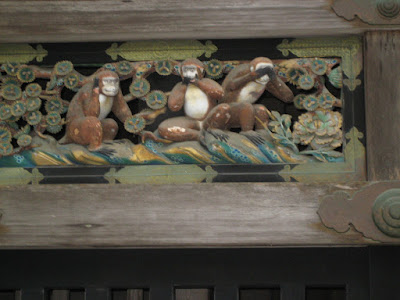You have possibly seen these 3 monkeys covering their ears, mouth and eyes... what do they represent? Where do they come from?
Before going to Japan, I had seen these 3 monkeys sometimes, but never wondered about their origin. I think I had seen them in some key holder or in some cartoon...
Last Summer in Japan, Professor Ito invited me, Paolo and Mic to go to Nikko, a nice city around 150 km North of Tokyo, in the middle of the mountains and which houses some temples, incluiding the mausoleum of one Shogun, Ieyasu, and his grandson Iemitsu. Once there, I found out one of the most famous things in Nikko where the 3 wise monkeys! They are just 3 tiny monkeys carved in the wood at the entrance of a small house... I was surprised something so small in size can be so meaningful, so I looked a bit into the topic.

Now, let's get down to the history behind. The three actions performed by the monkeys (don't see, don't hear, don't speak) in Japanese are Mizaru, Kikazaru and Iwazaru. The word "saru" 猿 means monkey. This play on words materialized in the 3 carved monkeys in Nikko. Like this, additionally, the monkey has become a symbol of negation in Japan.
The philosophy behind is as follows:
This explanation sounds good to me... if you have some comments or if you find some flaw in it, please tell me!!To become wise, don't see anything evil, don't listen to anything evil and don't say anything evil.
2 comments:
back home we also call them Gandhiji's three monkeys.
Mahatma Gandhi also said the same thing.. "See no evil, speak no evil and hear no evil"
Concise yet overflowing with meaning.
-Amruta
Naoko told me yesterday about the 4th monkey...don't do anything evil... do you have it as well?
Post a Comment